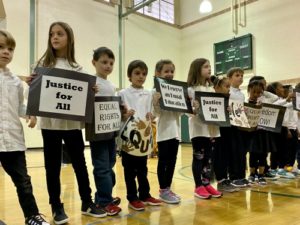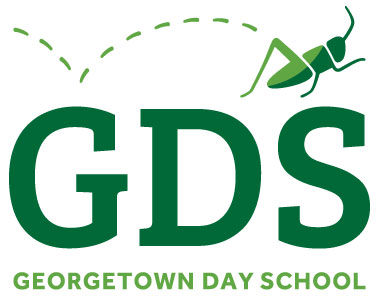Civil Rights education at Georgetown Day Lower School begins at the earliest ages. From their first introduction in Pre-K/K to an in-depth study in 5th grade, students are exposed to the concepts of segregation and discrimination, equality and justice, as well as forms of protest and advocacy. Our philosophy states that, “GDS graduates leave the School with a love of learning, an abhorrence of bigotry and intolerance, a broadly rounded fund of knowledge, the ability to enter the great conversations of life, and the willingness and capacity to bring needed change to a troubled world.” We believe that understanding our civil rights history and learning the lessons from this period of monumental social change are key to accomplishing this goal. Therefore, it is a major part of the curriculum in both 1st and 5th grade, culminating in a joint Martin Luther King, Jr. assembly. As you can imagine, an education in civil rights looks very different for 1st graders and 5th graders, but they are focused on the same goals and teach many of the same concepts.
Equality and Justice
1st: This is an easy concept to teach in first grade. A 6-year-old is acutely aware of what it means to be fair. They know when the cookies are not divided equally and they are the first to complain if one student gets a second serving of lemonade. “That’s not fair” is a frequent refrain heard in first grade classrooms. So when we explain the inequity of segregation and discrimination, first graders get it, it’s not fair. They quickly grasp that equality means we all get a chance to have cookies and lemonade, go to a good school, sit anywhere on the bus, vote, and marry who we want to marry.
5th: By the time students reach fifth grade, they look outside their immediate world and have begun to recognize global inequalities. In their service learning sessions, they express their feelings and do human-centered research about topics such as food and education disparities, the plight of the homeless, and other human rights issues. They learn to apply the concept of equality to someone besides themselves and see the injustice that still exists at home and abroad.
Discrimination and Segregation
1st: We recently conducted a segregation simulation to give our students a tiny peek at the emotional psychological impact of segregation. We assigned students to a group, blue or red, and then “segregated” them at different times of the day, switching back and forth to give them an experience of privilege, as well as discrimination. One group got an extra snack and later the other group got a special lunch, while the other students sat at plain tables with no extra treats. Some students enjoyed the privilege and laughed at those who were excluded. While other students tried to break the rules and called out, “This is segregation!” This simulation is preceded by lessons on Jim Crow and reading books about the segregated South, particularly those that highlight how children were affected.
 5th: Each year, fifth graders spend several weeks following winter break focusing on the American Civil Rights Movement. In addition to learning about Mohandas Gandhi and the impact that his philosophy of non-violence had on Dr. King, students learn about Jim Crow laws and protests such as sit-in demonstrations and marches to achieve full integration of public facilities. They are frequently shocked to learn that Washington, DC and the surrounding suburbs were segregated. One of the most compelling stories is when they learn that even after the Supreme Court’s 1954 ruling in the Brown v Board of Education case, officials in Prince Edward County, Virginia closed schools rather than integrate them. In 1961, then Georgetown Day School 9th Grade teacher Edyth Rich, took a risk and accompanied a group of students to Farmville, a town in Prince Edward County where makeshift classrooms for Black students were organized in church basements and meeting halls around town. Later, students from Farmville were hosted by GDS families during a trip to Washington. They spent time at the U.S. Supreme Court, visited churches and synagogues, and spent an afternoon at Glen Echo Park which had just recently been integrated.
5th: Each year, fifth graders spend several weeks following winter break focusing on the American Civil Rights Movement. In addition to learning about Mohandas Gandhi and the impact that his philosophy of non-violence had on Dr. King, students learn about Jim Crow laws and protests such as sit-in demonstrations and marches to achieve full integration of public facilities. They are frequently shocked to learn that Washington, DC and the surrounding suburbs were segregated. One of the most compelling stories is when they learn that even after the Supreme Court’s 1954 ruling in the Brown v Board of Education case, officials in Prince Edward County, Virginia closed schools rather than integrate them. In 1961, then Georgetown Day School 9th Grade teacher Edyth Rich, took a risk and accompanied a group of students to Farmville, a town in Prince Edward County where makeshift classrooms for Black students were organized in church basements and meeting halls around town. Later, students from Farmville were hosted by GDS families during a trip to Washington. They spent time at the U.S. Supreme Court, visited churches and synagogues, and spent an afternoon at Glen Echo Park which had just recently been integrated.
Advocacy and Protest
1st: In preparation for the MLK assembly, the first graders learn the protest songs that energized, inspired, and focused protesters during the civil rights movement. The students begin to recognize the power of these songs. After our segregation simulation they were marching around the playground with signs and singing freedom songs to protest the injustice of the simulation. The debriefing at the end of the day focused on how it felt to be in each of the groups and most importantly, what you can do from your position of privilege to address the inequity. In years past, we have had students apply these lessons to other situations that they found injust. For example, when they wanted a longer recess or more chocolate milk, students wrote letters, made signs, and took their grievances to the principal to try to bring about change. Students have taken it to a larger stage as well; one 2nd grader wrote her congressman to encourage him to support same sex marriage and 1st grade students wrote to Scholastic to protest a racist depiction of George Washington’s enslaved chef.
5th: During our service learning sessions, fifth graders focus on empathy, perseverance, collaboration, and creativity—all qualities that were exemplified during the American Civil Rights Movement. The “changemakers,” as the fifth graders refer to themselves, are working in groups doing research about human rights and global issues for which they are passionate. To kick-off the program which began the week that we returned from winter break, the students read and listened to Dr. King’s “I Have a Dream” speech. They were then asked to write their own connection between that 1963 speech and how to become changemakers in 2020.
The first and fifth grades focus on the civil rights movement to teach these core principles and help students interpret the events and apply them to current events. However, at every grade level, the teachers of Georgetown Day School expose their students to the concepts of equality and justice, help them to understand segregation and discrimination, and encourage them to use the tools of advocacy and protest to promote a more just and equitable world.


